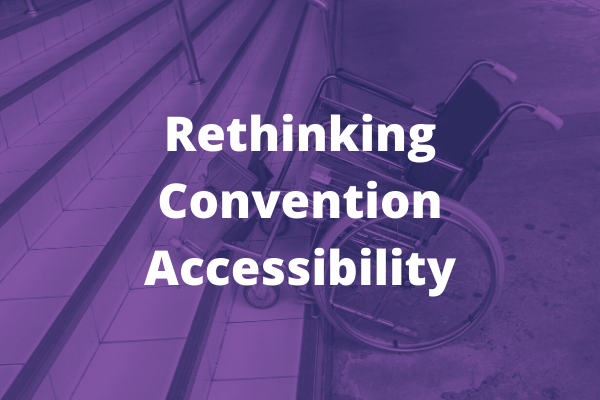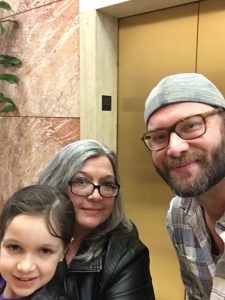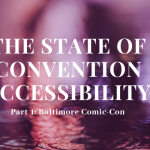Teresa Cleghorn Talks About How Conventions Can Improve Accessibility

Since we’re taking the summer off from in-person conventions, this seems like the perfect opportunity to rethink convention accessibility. Too often the needs of people with mobility issues are barely considered past making sure there’s an elevator somewhere in the building. With so much time before next year’s convention cycle (fingers crossed!), organizers have a chance to build accessibility into their planning from the beginning.
Teresa Cleghorn, a veteran of both the US military and the fandom convention circuit, has some thoughts about how ADA coordinators are overlooking key aspects of accessibility.
Teresa Cleghorn has been going to conventions for more than 25 years, mostly in Texas. She used a wheelchair for years after being hit by a truck and still has mobility impairments that require the use of a rollator. Teresa gave us some time to share her view of how convention accessibility falls flat and how it could be improved.
The Geekiary: What problems have you run into using your chair at conventions?
Teresa Cleghorn: In panel rooms, many conventions think they can pull out a chair at the end of a row & voila! They think that’s a wheelchair space. There are several problems with that:
- Adult wheelchairs are considerably wider than most convention seats, meaning that there is not enough space to actually fit a chair.
- The aisles are rarely wide enough to allow a wheelchair user to “park” without hitting chairs nearby. Wheelchairs don’t shuffle sideways; they need about 60 inches to be able to make a 180 degree turn.
- The aisle width [usually] does not allow room to turn around, meaning a wheelchair user may need to attempt to back down an aisle to exit if they need to leave. Which is complicated by-
- People tend to stand in the aisles. Sometimes they’re waiting to ask questions of panelists, [or maybe] trying to get closer to take photos. People also park strollers, walkers, and sometimes big bags there as well.
The Geekiary: What about outside panel rooms?
Teresa Cleghorn: In Artist Alleys and Vendor areas, I frequently run into problems. One is that the aisles are narrow and people stop smack in the middle. Sometimes, I have to stop quickly and other patrons run into my chair. I have left conventions terribly bruised because of this. Remember, I cannot move sideways to avoid [collisions].
The second is that lines form across aisles, trapping me. There is also the problem of displays and tables which are set too high for someone in a seated position to see, and stalls completely lacking interior access for wheelchairs.
Finally, in restrooms there are usually many stalls. Of those one, at most two, are accessible (wide or deep enough to accommodate a chair and equipped with grab bars). Many attendees decide to use the accessible stall even though they do not have a disability. Sometimes they use it because they want to change into a cosplay. Sometimes… they just like the wider space.
I do not have the option of using another stall. Neither do other wheelchair users. Without those grab bars, I cannot use the toilet.
The Geekiary: Which conventions seemed to be very weak or unresponsive to accessibility concerns? Which were more on top of things?

Teresa Cleghorn: I had a bad experience at a Supernatural convention in Dallas. It had all the seating and aisle issues previously noted, but there were additional issues. I had a pass that covered autographs with all the guests. When it came time to line up for Mark Sheppard (he’s not just a Supernatural star! He’s in Firefly and Doctor Who, amongst others), they had him set up on a stage with steps leading up.
The convention worker’s answer to my question about how I was supposed to get his autograph was that I should send it up with someone else. I think everyone knows autographs are the only time most people get one-on-one interaction with the actors. I was disappointed. To make the story better, Mark Sheppard saw the problem and jumped off the stage to come sign my book. He had them move his table off the stage, too.
I’ve gone back to other Supernatural conventions since that first one I attended and never saw the same issue for autographs. Kudos to the organizers for fixing that problem.
My worst experience – and a convention I have never gone back to – was at Alamo City Comic Con. I wasn’t there long, but I was terribly bruised because booths were set so close and many people were running into me. I needed a restroom and the family one was out of order.
I went to a convention worker to explain that I needed to leave due to the conditions. She stuck her nose up and said, “Oh well. No refunds.”
The best convention, ironically, was held in the same convention hall in San Antonio. After several Supernatural conventions, years of Wizard Worlds, and some other comic cons I decided to attend SanJapan – San Antonio’s big anime convention.
I cried happy tears. They made sure patrons with disabilities felt valued. They have a system set up called SanJapan Cares where you register and their volunteers make sure you are seated first in panels like airlines do. No more running into other people!
SanJapan volunteers are great about making sure no one blocks your access back out of an aisle. The planners maintain wider aisles, and booths in artist alley and vendor areas are wider, too. SanJapan may have spoiled me for any other convention! It is so nice to feel like a valued guest and not an inconvenience.
The Geekiary: We have time now for organizers to think about what changes should be made. Do you have any advice on things they should consider about making it easier to attend a large convention in a wheelchair?
Teresa Cleghorn: When attending a large convention in a wheelchair, the person with the disability will need aisles kept free of bags, and other items, and people.
When people creep up the side aisles to get closer to the stage where the talent is… they are impeding egress. Also, when the audience spends a lot of their time standing, dancing, etc., they are blocking people who cannot stand from seeing at all.
The food areas and sales kiosks need to be set up with more room to move around, too.
The Geekiary: What do you wish you could say to ADA leads and other organizers?
Teresa Cleghorn: What could I say to ADA leads? Different disabilities need different things. If an attendee lets you know in advance that they have specific needs, maybe listen?
Thanks to Teresa for giving us so much of her time, and for sharing her experiences. Let’s hope some ADA coordinators see this and put some of their extra planning time into making conventions smoother for everyone!
Author: Khai
Khai is a writer, anthropologist, and games enthusiast. She is co-editor (alongside Alex DeCampi) of and contributor to “True War Stories”, a comic anthology published by Z2 Comics. When she’s not writing or creating games, Khai likes to run more tabletop RPGs than one person should reasonably juggle.
Help support independent journalism. Subscribe to our Patreon.
Copyright © The Geekiary
Do not copy our content in whole to other websites. If you are reading this anywhere besides TheGeekiary.com, it has been stolen.Read our


I am so happy to that our convention, San Japan, and our program San Japan Cares worked exactly as it should! People with disabilities should never have to feel inconvenienced and feel included in the experience of the convention. Hearing these stories give us the drive to continue to do more.